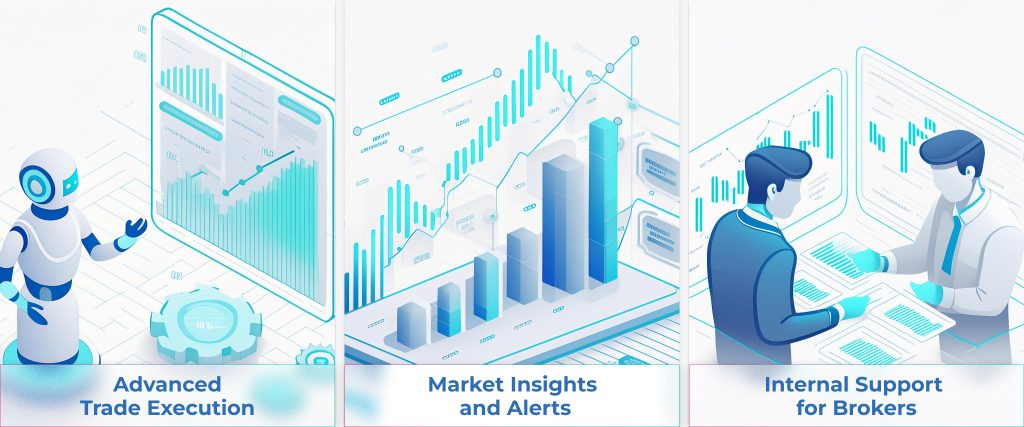Chatbots are evolving from simple, algorithmic query handlers to sophisticated virtual assistants capable of offering insight and solutions. Today, nearly 80% of financial institutions are leveraging chatbots, even if only in pilot projects. However, their role isn’t just confined to customer service, especially in the brokerage industry.
Bank of America’s Erica, for instance, not only responds to basic queries but also provides personalized financial advice and proactive notifications. Similarly, JP Morgan’s COIN program uses complex ML algorithms to review documents and legal contracts, saving the bank 360,000 hours of labor annually.
Utility beyond Customer Service
Although many institutions currently leverage chatbots to handle 70% of customer inquiries, there are other use cases where AI-powered bots can be implemented.
- Trade Execution
Advanced chatbots let traders execute trades directly through a chat interface on their phone or computer. Fidelity is experimenting with chatbots that let clients buy and sell securities with a simple text. TD Ameritrade’s AI-powered chatbot has successfully facilitated over 500,000 trades since 2018, demonstrating the practical application and scalability of this technology. Interestingly, TD Ameritrade saw a massive opportunity in the growing user base of social media platforms like Facebook to integrate this chat feature. This enabled them to tap into a much broader audience, meeting clients where they are, in a space they’re comfortable with.
- Market Insights and Alerts
Staying on top of the market used to mean sifting through endless reports and news articles. Now, chatbots can analyze vast amounts of data and send brokers and their customers timely insights and alerts. Robinhood’s chatbot keeps users updated on market movements, stock price changes, and relevant news. However, data accuracy and data quality issues can be a roadblock to achieving these chatbots full potential. Chatbots are only as good as the data they’re fed; aka GIGO (Garbage In, Garbage Out). The first challenge, therefore, is to ensure data accuracy. Before scaling up chatbots for various use cases, the answer lies in strategic data automation – automating repetitive manual data entry and building in robust data validation processes.
- Internal Support for Brokers
Brokers use AI-powered bots to gain quick access to client data, generate reports, and offer insights based on historical data. E*TRADE employs chatbots to support their brokers by offering real-time data analysis and client information retrieval. With this kind of support for brokers, productivity is substantially boosted. Brokers can handle more clients and transactions with the same level of precision, thus scaling their operations without a proportional increase in resources.
But there’s a flip side: that of over-reliance on AI. This can lead to a detachment from critical decision-making processes, where human intuition and experience are indispensable. While AI bots can handle routine tasks with high efficiency, they cannot replace the nuanced judgment and expertise of seasoned brokers. Firms must strike a balance between leveraging AI for efficiency and maintaining human oversight for quality assurance.
- Client Onboarding
Chatbots streamline complex onboarding processes by guiding clients through each step, collecting necessary information, and ensuring all documentation is complete. Interactive Brokers uses chatbots to help new clients open accounts and complete KYC (Know Your Customer) requirements efficiently. This not only speeds up the process but also makes it more user-friendly, enhancing the client’s first experience with the firm.

SEC and FINRA – Treading The Line of Cautious Optimism
Both the SEC and FINRA are taking a smart, careful approach to AI and chatbots. In a press conference, FINRA emphasized that firms must supervise AI-generated messages according to Rules 2210(a), 2210(b), and 3110 to align with regulatory standards. This guidance ensures AI communications are treated with the same rigor as human interactions.
SEC Chair Gensler’s recent remarks on AI and chatbot communications echo a similar sentiment:
“We must be vigilant in ensuring that the use of AI by market participants is consistent with our core principles of investor protection, market integrity, and fair competition.”
Where are We Headed?
The era of old-school, templated chatbots is over. AI and LLMs like GPT-4 are the new normal and the current strategy is “Throw chatbots against the wall and see what use cases stick.”
The next big opportunity lies in seeking transformative change rather than settling for incremental improvements. Today, the majority of firms are still stuck in this incremental mindset.
We may see a future where chat-based interactions redefine UI/UX, making complex dashboards obsolete. Users will simply engage in conversations with AI that understand financial goals, offer personalized advice, execute trades, and ensure compliance – all through natural language!
The potential benefits are nearly unlimited, but the time to adoption is currently the biggest variable in the market. Much like the trust we’ve developed in online banking over time, soon we’ll wonder how we ever managed without these innovative tools in the brokerage industry.


